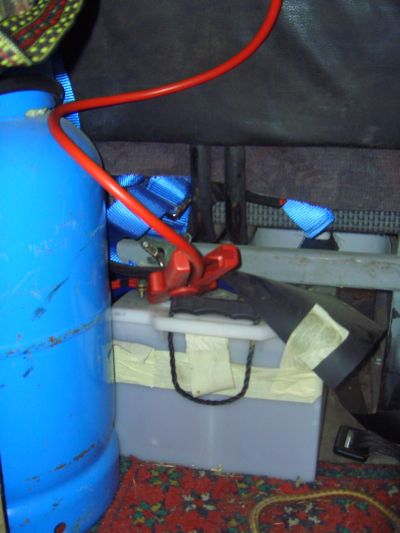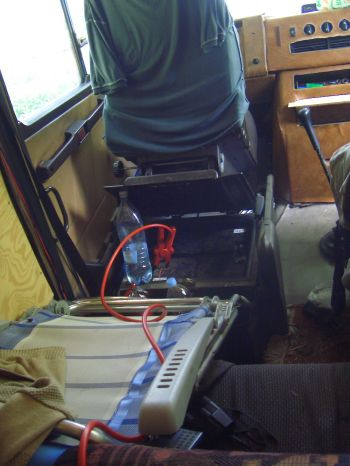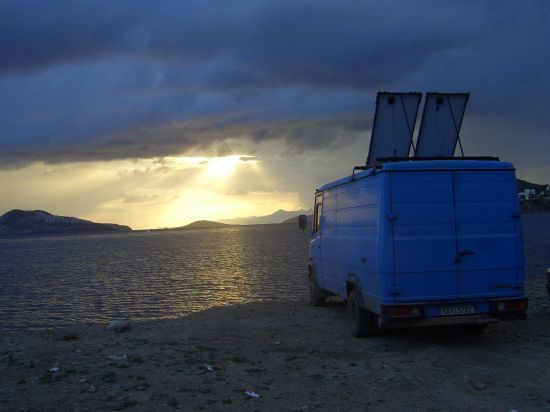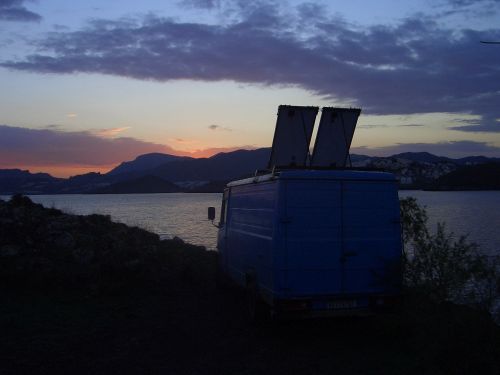
Caravan Electrical Connections

KENAX
Translation Agency and
Outsourcing
 |
Caravan Electrical Connections |
|
Of course everyone and their dog argued against me that it was simply not possible, but no, the solar panels are working absolutely magnificently and I am quite happy with them. My electrical needs are one to three laptops worth for 8 hours a day. For this I was advised to get two larger 110 Watt solar panels, which nicely fit on the top of my roof. I got them installed by a welder, who designed it so that they could be tilted in various ways and directions. But I donít even bother doing that, at least during the summer, as they seem to pick up enough light with a moderate sun angle, and even when cloudy. Furthermore, by being down and flat, they are not really visible, and hence not an attraction for local starving thieves. Most people are surprised to learn I have solar panels, but then I donít have a caravan but a discretely designed truck which doesnít attract attention in that department.
| Now during the day, and evening, Iíve been watching the regulator, which shows the strength of the battery, solar power, and consumption of what electricity I am using, and have learned to sense my limits. With these two solar panels, hence at 220 W, I find I can accomplish a lot during a sunny day, but what you need to do is look at consumption usage per device. Which is usually easy enough by picking up that little converter, the little black box between your computer and the electrical outlet, and read its power consumption levels. A light laptop can use about 50 W, but heavier laptops more, so look on the power rating on the back and do a simple calculation <show calculation>. So an input of 16V and 3.5Amps should work out to 56 Watts, like my laptop, and low enough that my 460 AmpHours of battery power seem to last right until the morning. Watch your caravanís battery power and try to keep it fully charged by the end of the day if you expect to do work during the evening. |
|
My regulator has excess power output terminals, so when the sun is high and dry and I am not using its full use, a second output starts releasing the excess energy. My battery could be fully charged, I could have several devices running at the same time, but still I have excess energy. So if everything is at full capacity, it is good to have something plugged into this output to take advantage of the extra power once it is generated. Although I donít have it set up yet and I still have to check out some things, what I have in mind is the fridge and the car battery. For the car battery, I have to check whether the extra charge could somehow damage the alternator. Anyway, while being parked somewhere for an extended period of time and not driving, I am thinking the extra energy could be appropriately used to keep the car battery at 100%, which those kinds of batteries should be kept at. Not only will this extend your batteryís life, but it will keep it fully charged once you want to rev up the beast and take off to the next destination. Or perhaps more important than this is the fridge. I donít really need a fridge and think it is unnecessary, as I buy what I eat every day, like fresh fruits, vegetables, maybe cheese and fresh bread, can of sardines etc. Or make a dinner that evening using the fresh vegetables, maybe fish right out of the ocean, rice which lasts forever, etc. etc. So I really donít see the need for a fridge. But maybe you could put spices in there so they donít heat up and fade in flavour. I got a basic cooler with a built in electric cooler (by electricity it reduces the inside temperature 20C from the outside temperature, and was only a little more expensive than a regular cooler), so I can grab it and take it to the beach as well. Practical is always key.
 |
 Charging the car battery from the boat battery, from the sun |
So the solar panels hook up to the regulator, which then charges the boat batteries. When the boat batteries are fully charged and there is excess power, from the regulator comes the additional 12V with which you can power extra things. Otherwise, the 12V boat batteries can be used to power various things in general. If you are lucky, you can power some 12V devices directly. Or you might have a converter from 12V into 6V, for example, but this can get expensive, as you would need separate converters for all devices having different voltages. The easiest is to hook up an inverter to the battery, which converts the 12V into 240V. I also have an inverter I bought in the US and which converts the 12V to 120V. Once you have that, you simply plug in an extension chord and all your devices into that. But by going from 12V to 240V, and then back down to 6V, means a certain loss of energy for the conversion process, I think as much as 30%. So I mostly use the 120V converter, as a lot of my devices can plug into either 120 or 240V (again, look at the little black box with your deviceís power chord to see what input it can handle). But I must warn you here that you should be very careful about turning off the inverter when devices are still plugged into it and turned on. For safety then, I use a power bar, which is basically an extension chord with its own switch, and inside it various fuses. Not too expensive but definitely worth it, as I already fried some devices like this. And you should also have a fuse between the battery and the regulator (refer to your regulatorís installation instructions). So, whenever leaving the truck (I like to turn everything off, because the last thing I want to return to from a pleasant walk is a pile of smoldering ashes), first turn off the extension chord, and then the inverter, to avoid any unwanted power surges. And what concerns the inverter, they come in different wattages. So youíll have to do some math to determine how much maximum wattage power you may need at any one time. I have a 300W 120V inverter, which seems plenty to run almost everything (at once), and a 500W 240V inverter for extra power. But the more you have running, obviously the quicker youíll kill your battery, if there is not enough sunshine to power everything. So keep a close eye on the regulator and soon enough youíll have a good feel of what you can get away with just by looking outside.
|
 |
And all this, amazingly, I installed myself. But when doing so, be very very careful about certain things. For example, two 230 Ah batteries in parallel makes 460 amp hours of energy. Or perhaps 460 hours worth of power to run a 1 amp device, like most laptops. I asked someone what would happen if I shorted the plus and minus contacts on such a power house and he said, "Well, you wonít really destroy the battery but drain it rather quickly. On the other hand, if it contacts that big metal rod is see holding up your bench seat and which I see is about 1 cm away from each contact, it will basically melt it into nothing, at the section between the contacts." So definitely enough power to fry your little heart if you held the plus in one hand and the minus in the other, for example. And considering that the minus is supposed to be connected to the frame of the vehicle, if your ankle is touching the leg of one of the front seats (which is obviously bolted to the metal frame of your car) and your left finger accidentally comes in contact with the plus on the battery, or any of the wires feeding out of it, you are fried my friend. So when setting up your system, either get an electrician (I tried but failed, and hence was forced to set this up myself, with my brother), or be extremely careful. Like my dad, the electronic engineer, said, "When working with electronics, you should always have one hand on what you are doing and the other one up your ass." That way you will not create a circuit going through your heart, which will mean immediate death. And once you are finished, make sure to think very careful about what could happen. If you get into an accident and the battery slides forward, can the contacts touch something? If so, bolt them to the floor, like I did. Or one person suggested fastening them somehow under the truck. And you should surround the contacts with all sorts of rubber and other non conductive material, protecting the region with wood so little children fingers could not get to it, and keep in mind that someone might spill water here or there. So be very careful about this my friends. 12V may seem like a small number, but itís the amperes that kill you, and how or where they travel through your body.
I hooked them up in parallel as suggested by the salesman, with the regulator hooked up to one of the batteries, but after a year and a half it seems that the battery closest to the regulator is much weaker, as if it has always been drained and charged first. So I would suggest you hook them both up to the regulator separately. Now that one seems much weaker than the other, once it gets dark I disconnect one of them and discharge them one at a time, since the weaker battery seems to drain the stronger one. If one is more drained than the other by morning, perhaps charge them separately.
I am told that these boat batteries should be maintained at a total charge of between 50 and 80%, which is hard to regulate if the sun is beaming all day long, meaning at 100% all day. But more importantly it is not supposed to go too low, I am told especially below 10.6V. At this level the electrical chemistry in the battery acid gets so low that the lead plates within the battery get damaged and you seriously reduce the capacity of the battery, so keep your eye on the regulator to make sure it is not getting too low. When I hit 20% I like to turn everything off, and I find that the battery can actually climb back to 80% after about four hours. As if my consumption rate was too high, draining the battery quickly, but that there is still lots of latent juices to draw from, once it has climbed back up.
|
|
I am learning this constantly, so I will try to update this section over time, but I believe it is quite important. For example, I find that when I use my fancy wifi antenna which hooks up through the usb port on my computer and the sun has gone down, I can kill the battery quite quickly. Or playing a movie through the laptopís internal DVD player can kill the battery before the movie ends. But I can write emails and do simple computer work right until the morning without putting a dent into the battery capacity at all. Or even charging a mobile battery requires a lot of consumption. So I charge all my other batteries (I donít even buy disposal pen batteries anymore and everything is rechargeable, so Iím like totally green dudes) when there is enough sun and remove my battery from the laptop when in night mode. In night mode, I might put the battery into my laptop, wait a few seconds until it registers, then disconnect the power source and spend a few minutes transferring a movie to the laptopís harddrive. This process alone has killed my boat batteries, but the laptop batteries seem to be able to handle these higher consumption levels. Or Iíll use the laptop batteries for wifi internet once the sun goes down, and switch back to boat batteries once Iím offline. Seems that watching a movie straight from the harddrive sucks much less energy. If I want to get fancy, I can have laptop speakers with their own power source/batteries running through the earphone output, but even adding the docking bay to my laptop, which has better speakers and the DVD drive, can suck noticeably more power. So youíll have to play around with this and experiment. Just make sure you do not drain your battery too much. It would definitely be a worthwhile investment to get one of those voltage meters. They are not expensive and you can get one in almost any electro shop. With this I can tell when my pen (AA or AAA) batteries are getting weak and when I should recharge them if I donít want to run out of power or music at some inconvenient time, or know when I should take advantage of a sunny day. Or if I am parked somewhere for a longer period of time, I can check my car battery, as the alarm system slowly sucks off that, or the car radio, or some of the lights. Car batteries should remain at near 100%, so you donít want to kill the capacity of those either. Once I found myself charging those from the sun as well, using jumper cables hooked up to my boat batteries, charged by the sun (pictures above). Just remember that these car batteries are also grounded to the vehicle, so really think things through before hooking up anything. A basic lesson from an electrician or car mechanic could definitely be a worthwhile investment. After all, itís your life. And screwing up the polarities on your batteries could cause them to explode, with battery acid in your face, and you can kiss your sight goodbye. I read once that you should have a damp cloth over car batteries when jump starting from another vehicle. And it is important what order you hook things up in. I generally remember that the plus/positive end must always be connected whether connecting or disconnecting the minus/negative/ground end.
 |
 |
Now catching the sun as it rises from the
east on the other side of the peninsula,
where I like to crash so I can see the sun fill the truck in the early morning.
And depending on your battery, you should check the level of the battery acid in it from time to time. They say you should pour some distilled water into any of the chambers if the level gets too low, which would expose any portion of the lead plates. If those get exposed to the air, they will get ruined in those sections, so check up on this from time to time. I will try to find some good links to this. Just be careful and study all this!
And when charging up mobile and those other NH3 <.. batteries, it is always good to discharge them as much as you can before fully charging them. I know they say that the newer ones donít really have a memory effect, but thatís baloney and they still do. These types of batteries have only so many cycles, and it is better to empty them fully before charging them fully. That way their capacity will remain at maximum, and you will not have to buy replacements as quickly. Actually, if you want to be smart like me (well, you can at least try, no?), since youíre going to buy replacements at some point anyway, go right ahead and buy those replacements in the very beginning. For your mobile, and backup pen batteries for your other devices. Use your device until the battery is totally dead, then simply throw in your fully charged backup battery and keep going. Not only will this mean that you have double the capacity, if you ever go camping or somewhere in the boonies without the possibility to recharge, but you will know exactly when to recharge your battery, you will get much longer life out of them, AND maintain their maximum capacity.
 |
For light, buy lots of candles. It makes for great ambient lighting and doesnít suck up unnecessary power. Or if it is a cloudy day and you are short of battery power, forget about movies and the radio and go natural. Pick up your guitar, or if it is a rainy day, just listen to the pitter patter Ė a soothing sound indeed while reading. Or just look outside at the ocean and watch the rain fall on the surface. Forget about all the gadgets, get out of the truck and dip in the ocean under the moonlight and rainy sky. That TV thing is a waste of time and made for city folk who have been ripped from the womb of nature. [However, if you really do need a TV, you can get an excellent and not so expensive USB thing which turns your laptop into a TV (a regular TV will suck up way too much juice). Analogue or digital, language stereo and the works. Invest into a half decent antenna system and you're set. Just research various products on the internet first, before buying.] |
In conclusion, even on a cloudy day, I find I can easily survive off the sun. Perhaps charging my various batteries (I only use rechargeable AA batteries now, so I can be fully environmental) at different times of the day, such that my digital cameral, portable radio and everything I have powers off the sun. If you get tired of the sitting in the truck, you can find a pub which will let you plug into their socket, so bring a splitter so you can secretly charge everything else at the same time. Or while in the internet cafť, or the restaurant with free wifi connection. I survived without a problem this way for a month in Prague before I hooked up my solar panels. But I have several backup batteries for my laptop, so a little juggling was required. In all, I find the concept beautiful. Right down to a hot and sunny day, with excess energy in my system, using electricity to create a little bastion of cool in a portable fridge, hence converting hot to cold, by itself.
 |
Over time one thing I found about the battery is that a certain amount of consumption can drain the battery too fast, forcing me to turn off more appliances as it gets darker. When the rate of depletion is too high, it drains the batteries faster than some comfortable discharge rate, and the metre starts dropping to a dangerously low level. When I have only my laptop plugged in, my two 240 Amh batteries seem to last without a problem until morning, unless it gets too cold in the caravan truck. But even when only using the laptop I find I can tweak its use to squeeze out more battery power:
| My laptop shows the charging activity (if yours doesn't perhaps you could find a useful program on the internet). At the bottom in the system tray you can see the light green 99%, which shows how fully the battery has been charged. But when I click for more battery details, I see that it is not being charged ("Battery - No Activity"). In this case I can dare to leave in the battery at night. I like to keep in the battery whenever possible because sometimes the regulator resets when there is a lot of sun, or automatically shuts down when the caravan battery strength gets too low, in which case my laptop turns off and I lose a lot of my offline work and have to restart the computer, which can be pretty annoying. |
|
| When surviving on the road like me, especially if your work and life depends on it, your battery can become the heart and one of the most important devices in your caravan. And like anything this important, you want to know how to take care of it well, so that it lasts long, and so that it works well. Different batteries work in different ways, and hence need to be taken care of differently. A normal car battery should always stay close to 100% fully charged. Dropping too low could seriously damage the battery, which is basically comprised of acid and some plates. If the voltage drops too low, chemicals within the acid crystallise and form onto the plate, reducing the efficiency and quality of the batter. If the liquid level drops too low and exposes some of the plates, crystallisation will form on the plate surface exposed to the air, and once again damage the battery. |
|
You should keep some distilled water for this purpose (not expensive and you should be able to buy it at every gas station) in case the liquid level ever drops too low. There are ways to specifically test the acid, or possibly refurbish the battery, but while traveling (in Eastern Europe and the Middle East) I found no one knew what the heck I was talking about, so you may be on your own. You could try ordering a kit from one of the weblinks provided below. Or hunt around for some laboratory which could help you. Otherwise, there are some simple tips to follow.
Here is some info I found on the net. Seemed rather complicated, but perhaps you might find it useful. Links one, two, three and four.
During a few fiery lightning storms it occurred
to me that I was sitting duck all by my lonesome parked on the beach in the middle of
nowhere, the only piece of metal for miles around. Considering all the insulation around
me I myself felt safe but I was worried about my electronics. For this reason I decided to
get switches for all the wiring, such as the ground to my stereo or from the solar panels
to the regulator. Basically at every connection where the lightning could fry my
electronics. Might as well get some sort of fusebox switch system and I'll ask the
salesman about this at the electrical parts shop.
I also thought it might be a good idea, during major storms, to lean
some thick metal rod outside against the side of the truck and the ground, to help ground
any lightning. Or perhaps you could think of getting a lightning rod. I still have to
research this. But so far, I asked my dad and he seemed to give me some good advice:
I don't suppose there is much you could do in case of a direct hit, which may very well
fry all your caravan electronics including some of the wiring.
You personally should be relatively safe inside your 'Faraday cage' (as long as you exit
and enter with care as noted below). On the other hand, I don't see why the Big Guy would
want to hit you by lightning, unless you do something silly, like park on top of a bare
hill.
There is a much bigger chance of a secondary discharge. When the charge in a cloud reaches
a potential sufficient to attract an opposite charge from the ground and punch an ionized
conductive channel through the air, it will discharge by electricity rushing up and down a
few times: crack crack crack, this motion of electrons at the same time inducing charge in
surrounding objects. Once I was gathering firewood at Mnichovice, when it started
thundering. I rushed in through a back metal gate and as soon as I closed it and stepped
away: caboom, lightning hit somewhere and there was a horizontal discharge between the
gate and a tree little over a meter away. Considering that air breaks down at about a
thousand volts per millimeter, you can see that secondary discharges can pack a punch of
their own.
The other thing to keep in mind is that, when lightning hits the ground, a potential may
appear between two different points on the ground, as the charge is dissipating (by
conducting away from the hit). That is why it's advisable not to stand with feet apart in
a thunder and when walking, only make small steps. Rubber wheels will protect the caravan truck against potentials caused by such ground currents. For
the same reason, if you choose to ground it, should be only in one place (preferably close
to where you get on and off). A metal rod leaning against the body is not much of a
ground; if you plan to stay longer in one place, you could run the rod in the ground and
connect it with a hefty wire to the chassis.
I am not sure about disconnecting the battery ground: if your electronics is grounded to
the chassis elsewhere, it might make no difference from a lightning point of view but
might be a good general precaution against shorts and leaks, as you mention. If however
your equipment is actually grounded solely through the battery's ground, disconnecting it
might deprive it of a degree of protection in case of lightning.
If your caravan truck stands on rubber wheels and is not
grounded, you should be careful getting in and out, as an electrical potential may develop
between the body and the ground especially in case of lightning. You should jump down
rather than stepping down while holding on or having one foot on the truck. To get on, you
can lean your metal rod against the caravan truck at the point
of entry before touching the body.
How
to Design a Caravan
How
to Construct a Caravan
Caravan
Beautification
Internet
Connection While Traveling
 |
Back to Euro Trip Page |
|
Copyright © KENAX, by Karel Kosman - All Rights Reserved Worldwide.